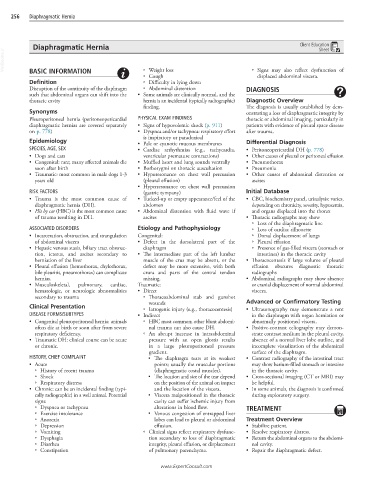Page 569 - Cote clinical veterinary advisor dogs and cats 4th
P. 569
256 Diaphragmatic Hernia
Diaphragmatic Hernia Client Education
Sheet
VetBooks.ir
○ Weight loss
BASIC INFORMATION
○ Cough ○ Signs may also reflect dysfunction of
displaced abdominal viscera.
Definition ○ Difficulty in lying down
Disruption of the continuity of the diaphragm ○ Abdominal distention DIAGNOSIS
such that abdominal organs can shift into the • Some animals are clinically normal, and the
thoracic cavity hernia is an incidental (typically radiographic) Diagnostic Overview
finding. The diagnosis is usually established by dem-
Synonyms onstrating a loss of diaphragmatic integrity by
Pleuroperitoneal hernia (peritoneopericardial PHYSICAL EXAM FINDINGS thoracic or abdominal imaging, particularly in
diaphragmatic hernias are covered separately • Signs of hypovolemic shock (p. 911) patients with evidence of pleural space disease
on p. 778) • Dyspnea and/or tachypnea: respiratory effort after trauma.
is inspiratory or paradoxical
Epidemiology • Pale or cyanotic mucous membranes Differential Diagnosis
SPECIES, AGE, SEX • Cardiac arrhythmias (e.g., tachycardia, • Peritoneopericardial DH (p. 778)
• Dogs and cats ventricular premature contractions) • Other causes of pleural or peritoneal effusion
• Congenital: rare; many affected animals die • Muffled heart and lung sounds ventrally • Pneumothorax
soon after birth • Borborygmi on thoracic auscultation • Pneumonia
• Traumatic: most common in male dogs 1-3 • Hyporesonance on chest wall percussion • Other causes of abdominal distention or
years old (pleural effusion) ascites
• Hyperresonance on chest wall percussion
RISK FACTORS (gastric tympany) Initial Database
• Trauma is the most common cause of • Tucked-up or empty appearance/feel of the • CBC, biochemistry panel, urinalysis: varies,
diaphragmatic hernia (DH). abdomen depending on chronicity, severity, hypoxemia,
• Hit by car (HBC) is the most common cause • Abdominal distention with fluid wave if and organs displaced into the thorax
of trauma resulting in DH. ascites • Thoracic radiographs may show
○ Loss of the diaphragmatic line
ASSOCIATED DISORDERS Etiology and Pathophysiology ○ Loss of cardiac silhouette
• Incarceration, obstruction, and strangulation Congenital: ○ Dorsal displacement of lungs
of abdominal viscera • Defect in the dorsolateral part of the ○ Pleural effusion
• Hepatic venous stasis, biliary tract obstruc- diaphragm ○ Presence of gas-filled viscera (stomach or
tion, icterus, and ascites secondary to • The intermediate part of the left lumbar intestines) in the thoracic cavity
herniation of the liver muscle of the crus may be absent, or the • Thoracocentesis if large volume of pleural
• Pleural effusion (hemothorax, chylothorax, defect may be more extensive, with both effusion obscures diagnostic thoracic
bile pleuritis, pneumothorax) can complicate crura and parts of the central tendon radiographs
hernias. missing. • Abdominal radiographs may show absence
• Musculoskeletal, pulmonary, cardiac, Traumatic: or cranial displacement of normal abdominal
hematologic, or neurologic abnormalities • Direct viscera.
secondary to trauma ○ Thoracoabdominal stab and gunshot
wounds Advanced or Confirmatory Testing
Clinical Presentation ○ Iatrogenic injury (e.g., thoracocentesis) • Ultrasonography may demonstrate a rent
DISEASE FORMS/SUBTYPES • Indirect in the diaphragm with organ herniation or
• Congenital pleuroperitoneal hernia: animals ○ HBC most common; other blunt abdomi- abnormally positioned viscera.
often die at birth or soon after from severe nal trauma can also cause DH. • Positive-contrast celiography may demon-
respiratory deficiency. ○ An abrupt increase in intraabdominal strate contrast medium in the pleural cavity,
• Traumatic DH: clinical course can be acute pressure with an open glottis results absence of a normal liver lobe outline, and
or chronic. in a large pleuroperitoneal pressure incomplete visualization of the abdominal
gradient. surface of the diaphragm.
HISTORY, CHIEF COMPLAINT ■ The diaphragm tears at its weakest • Contrast radiography of the intestinal tract
• Acute points; usually the muscular portions may show barium-filled stomach or intestine
○ History of recent trauma (diaphragmatic costal muscles). in the thoracic cavity.
○ Shock ■ The location and size of the tear depend • Cross-sectional imaging (CT or MRI) may
○ Respiratory distress on the position of the animal on impact be helpful.
• Chronic: can be an incidental finding (typi- and the location of the viscera. • In some animals, the diagnosis is confirmed
cally radiographic) in a well animal. Potential ■ Viscera malpositioned in the thoracic during exploratory surgery.
signs: cavity can suffer ischemic injury from
○ Dyspnea or tachypnea alterations in blood flow. TREATMENT
○ Exercise intolerance ■ Venous congestion of entrapped liver
○ Anorexia lobes can lead to pleural or abdominal Treatment Overview
○ Depression effusion. • Stabilize patient.
○ Vomiting ○ Clinical signs reflect respiratory dysfunc- • Resolve respiratory distress.
○ Dysphagia tion secondary to loss of diaphragmatic • Return the abdominal organs to the abdomi-
○ Diarrhea integrity, pleural effusion, or displacement nal cavity.
○ Constipation of pulmonary parenchyma. • Repair the diaphragmatic defect.
www.ExpertConsult.com

